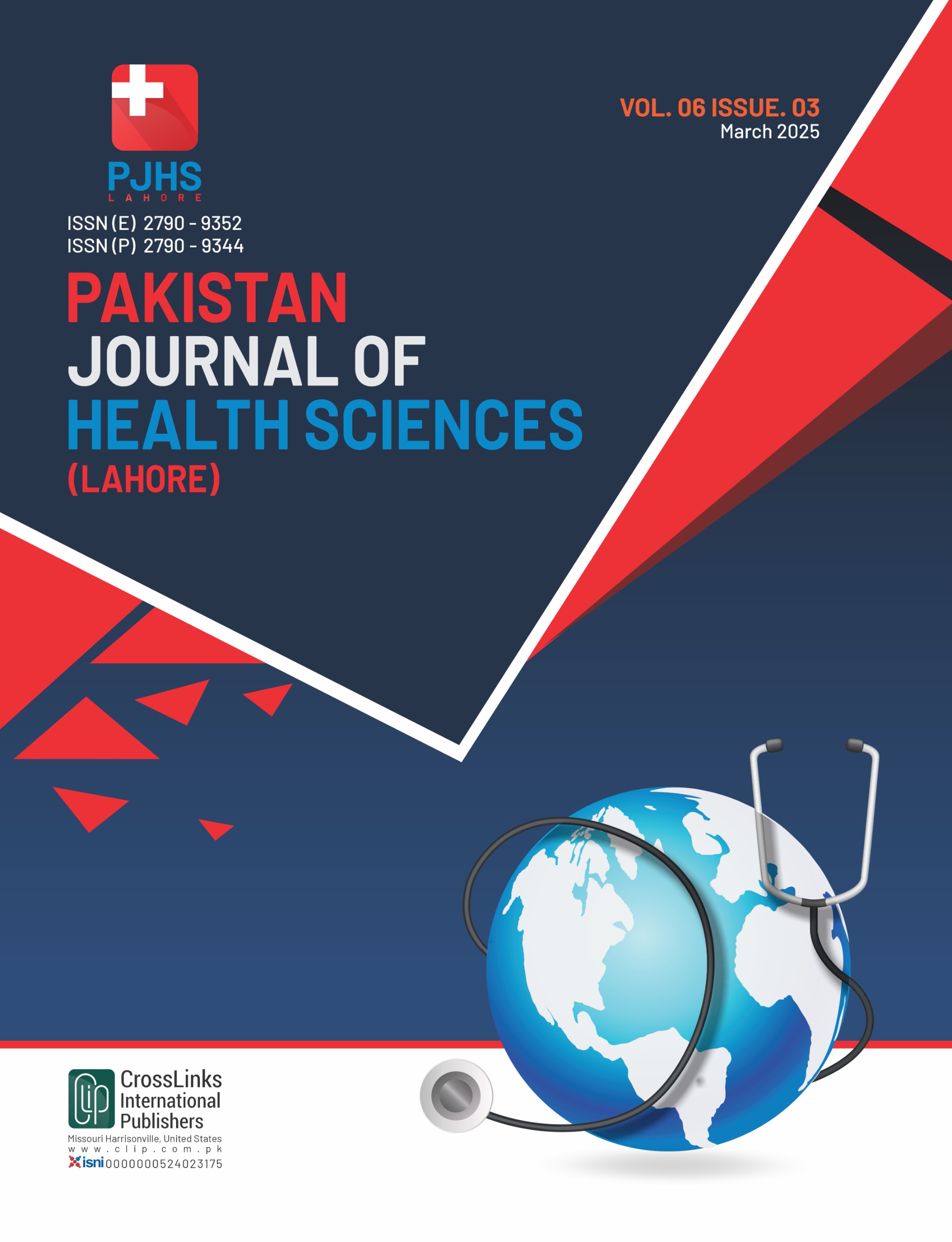Determination of Frequency and Risk Factors of Ureteral Stent Encrustations in a Tertiary Care Hospital
Frequency and Risk Factors of Ureteral Stent Encrustations
DOI:
https://doi.org/10.54393/pjhs.v6i3.2837Keywords:
Ureteral Stent Encrustation, Urolithiasis, Urinary Tract Infection, ProteinuriaAbstract
Ureteral stent encrustation is a common problem, with incidence rates rising from 9% at 6 weeks to over 75% after 12 weeks of indwelling time. Objective: To determine the frequency and associated risk factors of the ureteral stent encrustation in patients with urolithiasis. Methods: This was a prospective descriptive study, conducted at the Department of Urology, JPMC, Karachi, Pakistan. All patients who visited to JPMC and fulfilled the inclusion criteria were included in the study after their consent. Stent duration was grouped into ≥ 6 weeks and < 6 weeks. The stent removal was done under general or local anesthesia. All the collected data were entered into the pre-defined study proforma. Results: Mean ± SD of age was 39.60 ±12.06 years. In the distribution of gender, 43 (58.9%) were male while 30 (41.1%) were female. Ureteral stent encrustation was noted in 11 (15.1%) patients. In the comparison of urinary tract infection and proteinuria, with and without ureteral stent encrustation was noted as 9.6% v/s 5.5% and 11% v/s 4.1%, and the p-value was found to be highly significant i.e., p < 0.0001. Conclusions: This study concluded that ureteral stent encrustation was prevalent in patients with urolithiasis. It is significantly associated with urinary tract infection and proteinuria. However, more prospective and well-controlled trials are needed to validate the current findings.
References
Guo H and Yuan JB. New insights into the prevention of ureteral stents encrustation. Open Medicine. 2023 Dec; 18(1): 20230854. doi: 10.1515/med-2023-0854. DOI: https://doi.org/10.1515/med-2023-0854
Liu Z, Yan M, Naji Y, Qiu J, Wang H, Lin Y et al. Can Double J stent encrustation be predicted by risk analysis and nomogram?: A retrospective case-control study. Medicine. 2024 Jan; 103(2): e35303. doi: 10.1097/MD.0000000000035303. DOI: https://doi.org/10.1097/MD.0000000000035303
Qiu J, Yan M, Wang H, Liu Z, Wang G, Wu X et al. Identifying ureteral stent encrustation using machine learning based on CT radiomics features: a bicentric study. Frontiers in Medicine. 2023 Aug; 10: 1202486. doi: 10.3389/fmed.2023.1202486. DOI: https://doi.org/10.3389/fmed.2023.1202486
Lombardo R, Tubaro A, De Nunzio C. Ureteral Stent Encrustation: Epidemiology, Pathophysiology, Management and Current Technology. Letter. Journal of Urology. 2022 Jan; 207(1): 248-9. doi: 10.1097/JU.0000000000001678. DOI: https://doi.org/10.1097/JU.0000000000001678
Dillinger C, Amado P, Obrist D, Burkhard FC, Clavica F, Ahmed D. On-Demand Encrustation-Repellent Ureteral Stent/Catheter Surface: A Novel Bioinspired Ultrasonic Approach. Continence. 2024; 12(s): 101594. doi: 10.1016/j.cont.2024.101594. DOI: https://doi.org/10.1016/j.cont.2024.101594
Liu R, Yang J, Zhang W, Li X, Shi D, Cai W et al. Radiomics model using preoperative computed tomography angiography images to differentiate new from old emboli of acute lower limb arterial embolism. Open Medicine. 2023 Mar; 18(1): 20230671. doi: 10.1515/med-2023-0671. DOI: https://doi.org/10.1515/med-2023-0671
Dimitrijevic Z, Paunovic G, Tasic D, Mitic B, Basic D. Risk factors for urosepsis in chronic kidney disease patients with urinary tract infections. Scientific Reports. 2021 Jul; 11(1): 14414. doi: 10.1038/s41598-021-93912-3. DOI: https://doi.org/10.1038/s41598-021-93912-3
Li Y, Yuan K, Deng C, Tang H, Wang J, Dai X et al. Biliary stents for active materials and surface modification: recent advances and future perspectives. Bioactive materials. 2024 Dec; 42: 587-612. doi: 10.1016/j.bioactmat.2024.08.031. DOI: https://doi.org/10.1016/j.bioactmat.2024.08.031
Rahman A, Khan N, Khalil A, Ali M. Forgotten JJ stents with stones formation, spontaneous fragmentation, management and outcomes in a case series. Khyber Journal of Medical Sciences. 2023 Jul; 16(3): 157. doi: 10.70520/kjms.v16i3.425. DOI: https://doi.org/10.70520/kjms.v16i3.425
Irizato M, Sato Y, Murata S, Chatani S, Ouchi A, Kinoshita T et al. Successful ureteral stent placement with rendezvous technique for ureteral obstruction after urinary diversion: A case report. Radiology Case Reports. 2024 Nov; 19(11): 4908-11. doi: 10.1016/j.radcr.2024.07.079. DOI: https://doi.org/10.1016/j.radcr.2024.07.079
Tomer N, Garden E, Small A, Palese M. Ureteral stent encrustation: epidemiology, pathophysiology, management and current technology. The Journal of Urology. 2021 Jan; 205(1): 68-77. doi: 10.1097/JU.0000000000001343. DOI: https://doi.org/10.1097/JU.0000000000001343
Bhardwaj M and Ingole N. Application, advancement, and complication of ureteral stent and encrustation: A major complication. Cureus. 2022 Aug; 14(8). doi: 10.7759/cureus.28639. DOI: https://doi.org/10.7759/cureus.28639
Juliebø-Jones P, Pietropaolo A, Æsøy MS, Ulvik Ø, Beisland C, Bres-Niewada E et al. Endourological management of encrusted ureteral stents: an up-to-date guide and treatment algorithm on behalf of the European Association of Urology Young Academic Urology Urolithiasis Group. Central European Journal of Urology. 2021 Dec; 74(4): 571. doi: 10.5173/ceju.2021.0264. DOI: https://doi.org/10.5173/ceju.2021.0264
AL-Khikani FH and Ayit AS. Non-Bacterial Urinary Tract Infections: Unveiling a Hidden Challenge in Urology and Infectious Disease Research. World News of Natural Sciences. 2025 Mar; 60: 181-94.
Wang X, Ji Z, Yang P, Li J, Tian Y. Forgotten ureteral stents: a systematic review of literature. BioMed Central Urology. 2024 Mar; 24(1): 52. doi: 10.1186/s12894-024-01440-9. DOI: https://doi.org/10.1186/s12894-024-01440-9
Hsu JS, Huang CY, Liu KL, Chow PM. Risk factors for primary failure of metallic ureteral stents: experience from a tertiary center. Journal of Endourology. 2021 Jun; 35(6): 912-8. doi: 10.1089/end.2017.0611. DOI: https://doi.org/10.1089/end.2017.0611
Aljbri W, Ahmed F, Nikbakht HA, Al-Naggar K, Al-wageeh S, Ghabisha S et al. Encrusted ureteral double J stents risk factors: A retrospective study. Journal of Emergency Medicine, Trauma & Acute Care. 2022 Nov; 2022(5): 31. doi: 10.5339/jemtac.2022.31. DOI: https://doi.org/10.5339/jemtac.2022.31
Akhtar M, Usman HM, Lodhi MH, Zafar Z, Ullah MS, Khan MU et al. Frequency of Ureteral Stent Encrustations in a Urology Unit of Tertiary Care Hospital. Pakistan Journal of Medical & Health Sciences. 2022 Nov; 16(09): 709-. doi: 10.53350/pjmhs22169709. DOI: https://doi.org/10.53350/pjmhs22169709
Waseda Y, Takazawa R, Kobayashi M, Yoshida S, Uchida Y, Kohno Y et al. Successful outcomes of endoscopic lithotripsy in completely bedridden patients with symptomatic urinary calculi. Scientific Reports. 2020 Jun; 10(1): 8839. doi: 10.1038/s41598-020-65807-2. DOI: https://doi.org/10.1038/s41598-020-65807-2
Soria F, Rako D, de Graaf P. Urinary Stents: Current State and Future Perspectives. 2022 Aug. doi: 10.1007/978-3-031-04484-7_1. DOI: https://doi.org/10.1007/978-3-031-04484-7
Downloads
Published
How to Cite
Issue
Section
License
Copyright (c) 2025 Pakistan Journal of Health Sciences

This work is licensed under a Creative Commons Attribution 4.0 International License.
This is an open-access journal and all the published articles / items are distributed under the terms of the Creative Commons Attribution License, which permits unrestricted use, distribution, and reproduction in any medium, provided the original author and source are credited. For comments













